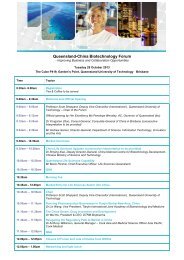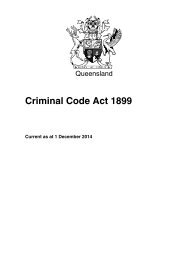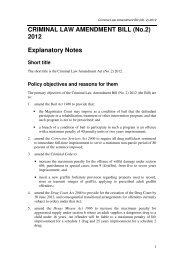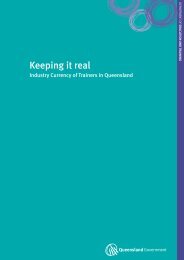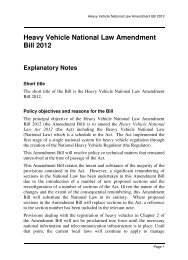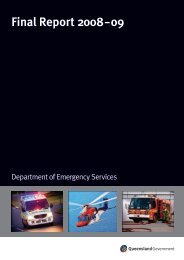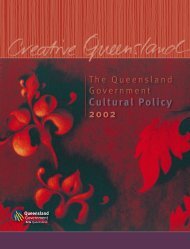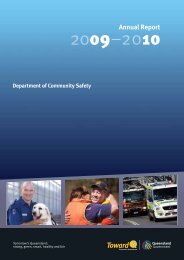Queensland Life Sciences Industry Report 2012 (PDF, 3.5MB)
Queensland Life Sciences Industry Report 2012 (PDF, 3.5MB)
Queensland Life Sciences Industry Report 2012 (PDF, 3.5MB)
You also want an ePaper? Increase the reach of your titles
YUMPU automatically turns print PDFs into web optimized ePapers that Google loves.
<strong>Queensland</strong> <strong>Life</strong> <strong>Sciences</strong> <strong>Industry</strong> <strong>Report</strong> <strong>2012</strong><br />
66<br />
were international companies, Bioniche from Canada,<br />
which is cross-listed on the ASX and TSX, and US company,<br />
GI Dynamics.<br />
Across the biotechnology industry globally, the number of<br />
IPOs dropped in FY2011. The median ‘age’ of companies<br />
at IPO has increased from five years (1999–2001) to<br />
nine years (2008–2010), making exits more difficult and<br />
putting pressure on VCs, whose funds often have 10 year<br />
timeframes. 97<br />
Figure 32: <strong>Life</strong> <strong>Sciences</strong> company IPOs on the ASX, 2007-2011 98<br />
According to the Australian Private Equity & Venture Capital<br />
Association, total private equity and VC funds raised during<br />
FY2011 grew by 72% compared to FY2010. 99 However, new<br />
funding commitments to Australian VCs continued a decline<br />
that commenced in FY2008. Three VC funds raised a total<br />
of $120 million in FY2011, down 35% from FY2010 (13 funds<br />
raised $158 million) and 40% from FY2009 (7 funds raised<br />
$299 million). In both 2010 and 2011, the majority of VC<br />
commitments were from Government-backed innovation<br />
funding programmes e.g. Innovation Investment Fund. In<br />
Australia, <strong>Life</strong> <strong>Sciences</strong> (including healthcare) 100 companies<br />
received 58% of all VC amounts invested and accounted for<br />
51% of all investee companies. 101<br />
These investment trends have significant implications<br />
for <strong>Life</strong> <strong>Sciences</strong> companies, particularly because VC<br />
funding is often critical for early stage development of new<br />
technologies. Investments tended to favour later stage<br />
companies, later stage funding rounds and existing investee<br />
companies, with follow-on rounds accounting for 70% of<br />
total VC amounts invested in FY2010. 102 Data from the OECD<br />
also showed that the majority of VC investments in Australia<br />
(68%) were devoted to later stage investments rather than<br />
pre-seed/seed/start-up investments. 103 This trend across<br />
the Australian <strong>Life</strong> <strong>Sciences</strong> <strong>Industry</strong> is mirrored in the<br />
results from the current survey: 88.7% of reported capital<br />
was sourced from existing shareholders and ‘other private<br />
equity’, whilst venture capital and business angel funding<br />
provided less than 4% of finance raised.<br />
According to the Ernst & Young Beyond Borders report,<br />
large debt financings by mature, profitable biotechnology<br />
companies in the US grew by 150% in 2010. However, once<br />
debt financings by mature companies were removed from<br />
the dataset, a 20% decline in the amount of the remaining<br />
‘innovation capital’ was evident. The majority of this funding<br />
(82.6%) was received by 20% of companies, while the bottom<br />
20% of companies raised 0.4% of total funds. As in previous<br />
years, Ernst & Young described an industry divided by the<br />
‘haves’ and ‘have nots’, with funds concentrated into a<br />
smaller group of companies. 104<br />
In Australia, BioShares reported that the publicly-listed<br />
biotechnology industry raised $630 million in 2011, up 14%<br />
on the $554 million in 2010. 105 However, Ernst & Young<br />
noted that medical devices companies rather than core<br />
biotechnology companies were increasingly benefiting from<br />
capital raised. 106<br />
10.3 Intellectual Property<br />
Patent application filings are one parameter used to indicate<br />
innovation activity and the importance placed on patents<br />
is evidenced by the estimated 7.3 million that were in force<br />
worldwide in 2010. 107<br />
The number of patent filings globally declined by 3.6% in<br />
2009 but increased by 7.2% in 2010 to 1.98 million, driven<br />
by applications from China and the US. The number<br />
of PCT patent filings globally fell by 4.8% in 2009 and<br />
this decline is likely a consequence of the GFC and its<br />
impact on the availability of capital to fund innovation and<br />
commercialisation, leading to reduced R&D expenditure and<br />
more selective expenditure on IP protection. The number<br />
of PCT filings grew by 5.7% in 2010, with applications<br />
from China, Japan and Korea accounting for 94% of this<br />
increase. 108<br />
The number of patent applications where Australia is listed<br />
as the country of origin, declined in 2009 for the first time<br />
since 1999 (Figure 33 – opposite).<br />
An analysis was done of the number of published patents<br />
originating in Australia across four main technology areas<br />
relevant to the <strong>Life</strong> <strong>Sciences</strong> sector (i.e. biotechnology,<br />
pharmaceuticals, environmental technology and food<br />
chemistry). This analysis revealed that, with the exception<br />
of pharmaceutical patents, the steady increase in patent<br />
applications across all sectors between 2002 and 2005<br />
97 Ernst & Young, Beyond Borders, 2011<br />
98 PwC BioForum Publication Edition 36, Quarter 4 FY11, August 2011, PwC BioForum, Edition 25, Quarter 4 FY08, August 2008.<br />
99 Australian Private Equity & Venture Capital Association<br />
100 Note: AVCAL’s <strong>Life</strong> <strong>Sciences</strong> definition includes healthcare<br />
101 Australian Private Equity & Venture Capital Association, Yearbook, 2011<br />
102 Australian Private Equity & Venture Capital Association, Yearbook, 2011<br />
103 OECD (2011), Entrepreneurship at a Glance 2011, based on OECD Entrepreneurship Financing Database, June 2011.<br />
104 Ernst & Young, Beyond Borders 2011<br />
105 Australian <strong>Life</strong> Scientist, ‘A new year, a new look and good news is rolling in already’, 12 January, <strong>2012</strong><br />
106 Ernst & Young, Beyond Borders, 2011<br />
107 World Intellectual Property Organisation, World Intellectual Property Indicators, 2011, http://www.wipo.int/export/sites/www/freepublications/en/<br />
intproperty/941/wipo_pub_941_2011.pdf<br />
108 World Intellectual Property Organisation, World Intellectual Property Indicators, 2011.



